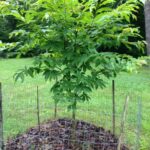
Although this tree may seem unfamiliar to many people today, it once played a crucial role in the survival of people in Kentucky. The American chestnut (Casteana dentata) was once highly valued for its timber. The nuts of the tree served as an important food source for both humans and animals. During the first half of the 20th century, the American chestnut was almost completely wiped out due to the chestnut blight, a fungus that was introduced by humans. This fungus has evolved alongside the chestnuts of China and Japan, keeping those trees healthy, but our chestnuts had no such resistance to the fungus. By the 1940s, nearly 4 billion American chestnut trees had died. Today only a handful of American chestnuts remain. Thankfully, Bernheim has been working closely with The American Chestnut Foundation, which is seeking to restore the tree to its native range in the Eastern United States. The American Chestnut Foundation seeks to accomplish this restoration by breeding a small amount of genes from the Chinese chestnut (Castanea mollissima) into the American chestnut in order to make the tree resistant to the chestnut blight. These hybrid trees are 94% American chestnut and 6% Chinese chestnut. Within Bernheim, they can be found planted off Forest Hill drive directly across from the Cull Hollow Loop. Hopefully, with the help of Bernheim, the American chestnut will once again be a key feature in the Kentucky landscape.
-Shane Stiles, Horticulture Intern

